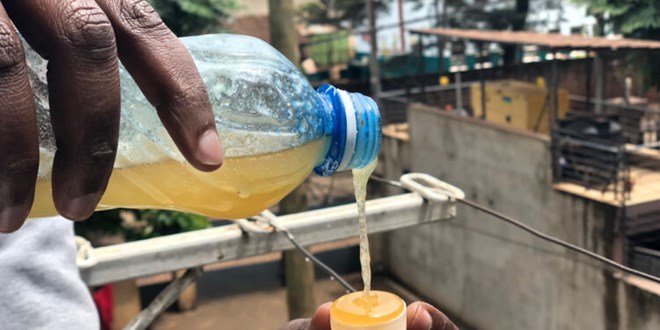
Thursday October 19, 2023

Kaydka Ergo
Omar Abdullahi Adan, 67, a Somali refugee living in Dadaab camps in north-eastern Kenya, is well known among the refugees for beekeeping.
He earns $200-$250 a month from honey sales that supports him and his family quite well.
advertisements
“I don’t have any other work; I only get my income from bees. I married my wife with money I made from beekeeping. On my best day I made 32,000 Kenya shillings ($213) from the honey sales,” he said.He keeps his bees in 21 boxes in a farm four kilometres away that he fenced. He goes there every morning to take the bees water.
His main customers are others living in Dhagahley the refugee camp, and he also has occasional orders from Nairobi or Dhobley in Lower Juba that he delivers through people travelling to those areas. He sells half a litre of honey for 1,200 shillings ($8) and three litres discounted at 6,000 shillings.
Omar managed to save $360 from honey sales in 2017 and bought one goat and two camels. His livestock have multiplied since then and he now has seven goats and five camels, herded by his relatives outside the camp.
He pays $32 a month in fees for six of his eight children studying at Koranic school.
Omar fled conflict in Bu’ale, in Somalia’s Lower Juba region, in 2015 and joined the refugee camp. He brought with him $56 from his bee keeping business in Bu’ale and used the money to start off in Dadaab by buying three boxes to store the bees.
Surviving on the 48 kilograms of sorghum and 4,950 shillings ($33) his family were allocated in aid was very hard. He feels that others in the camp could consider beekeeping as well to make a decent living.
Omar began beekeeping at the age of 15 and remembers his early novice period.
“The first day I tried to catch bees with no experience, I was stung badly. I fell unconscious and people had to splash water on me. I was carried away in car, I even vomited, but now I’m experienced I don’t get hurt!” he said.
Lacking any protective gear, he relies on the old method of using smoke to make the bees sleepy so they can be caught.
“There are three types of bees, dark bees, red bees, and striped bees. The red bees are very good for producing honey and I have collected them from all around Dhagahaley. To catch the bees, I smoke the bee hive on the tree so they start to fly out. That’s when I catch the queen bee and the rest of the bees will follow the queen. That’s how I trap them and take them to my hives,” he said.
He noted that bees only produce honey for six months of the year and spend the rest of the year reproducing. As trees, flowers, and water have been scarce during the recent drought, he has special means of keeping the bees productive.
“Whenever there is drought, I grind maize and put in on a plate on the tree. I also prepare tea, with cinnamon and cloves to give a good smell. The bees eat the food and drink the water and that’s how they keep producing the honey,” Omar explained.